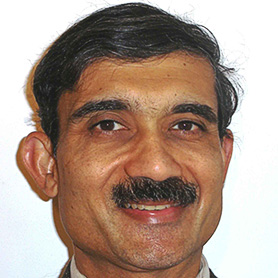Dr. Ravindra P. Joshi, Ph.D., P.E
Professor, Dept. of Electrical & Computer Engineering, Texas Tech University
Lectures
Pulsed Power Opens A Gateway to Biomedical Engineering: Tumor Treatment and Drug Delivery, to Nerve Stimulation and Beyond
In the past five years or so, the applications and potential uses of pulsed power in the form of high-intensity (> 100 kV/cm) nanosecond-duration electrical pulses on biological cells and tissue have gained considerable interest and attention. In its most basic form, pulsed power collects and stores energy over a period of ranging from seconds to minutes, and discharges it at very high power on a time-scale of tens of nanoseconds. In the biological context, such ultrashort pulse generation presents a unique non-thermal method of selectively penetrating through the outer cell membrane and directly affecting intracellular structures. It also offers possibilities for stimulating dielectric responses or affecting voltage-gated ion-channels in much the same way that field-effect transistors could be modulated. The non-thermal feature makes it a particularly attractive technology for biomedical applications where selectively targeted bio-responses are desired without any collateral tissue damage for optimal treatment.
Preliminary research has already shown very promising possibilities of directing this technology towards tumor killing, wound healing and sterilization, electrically activated gene-transfer and drug-delivery into cells, and neuromuscular therapeutic stimulation for rehabilitation. An even newer capability opens up when the voltage pulse duration is decreased further into the sub-nanosecond range. In this mode, wideband antennas can be driven to deliver energy and create electric fields within tissues. However, before any of these exciting possibilities become reality, an in-depth understanding of the processes and effects on the cellular and sub-cellular levels has to be achieved.
In this lecture, a review of the knowledge that has been gained during the past decade will be presented. First an overview of the basic concepts and physical principles of operation will be discussed. Research efforts and some of the exciting results on the killing of tumor cells, drug delivery, neuro-muscular stimulation and other electrically stimulated bio-responses will be presented. This will include the basic mechanisms at work, some of the kinetics involved, and the roles played by the electric fields in triggering various processes such as calcium release, initiation of the apoptotic pathway, and tissue ablation. Other aspects at the tissue level such as wound healing will also be highlighted in a simple illustrative manner.
About

Ravi Joshi received the B.Tech. and M.Tech. degrees in electrical engineering from the Indian Institute of Technology, Bombay, India, in 1983 and 1985, respectively, and the Ph.D. degree in electrical engineering from Arizona State University, Tempe, in 1988. He was a Postdoctoral Fellow at the Center of Solid State Electronics Research, Arizona State University. In 1989, he joined the Department of Electrical and Computer Engineering, Old Dominion University, Norfolk, VA, as an Assistant Professor where he is currently a Full Professor, and involved in research broadly encompassing modeling and simulations of high electric-field induced phenomena, nonequilibrium transport in plasmas, bioelectrics and bio-medical applications of pulsed power. He has also used Monte Carlo methods for simulations of high-field charge transport for semiconductor electronics. He is the author of more than 135 journal publications, and has been a Visiting Scientist at Oak Ridge National Laboratory, Philips Laboratory, Motorola, and NASA Goddard. He has also served as a Guest Editor for four Special Issues of the IEEE Transactions on Plasma Science, and is a Fellow of the IEEE.